Every house in which I’ve lived has had its garden problems: too much shade, too much moisture, too much sun, too much heat. The key to overcoming these garden problems is plant selection.
Just as every one of us has unique personal tastes, every plant has conditions that promote its best growth, conditions it will tolerate, and conditions where it will surely die. Forcing a plant to live where it will surely die means the end result is disappointment. Plant selection is important.
The best ways to select plants involve researching which plants perform in shade. One of my favorite gardening web sites Dave’s Garden has the care and cultural requirements of many plants so you can see what will survive in your area (sun, shade, and hardiness zone). These are submitted by gardeners just like us so we’re getting people’s personal experiences (positive, neutral, and negative) and advice on overcoming problems.
Here are photos of some of my favorite plants for part shade to full shade. As they continue to grow and bloom, I will post more photos. Redbud (Cercis canadensis, below left) and Serviceberry (Amelanchier canadensis, below right) are two “understory” trees which means that they can handle growing in the shade of taller canopy trees. They generally stay shorter and they adapt well to part shade conditions. Both flower in the springtime. The Serviceberry blossoms have faded but it has begun to set fruit which will develop fall color in addition to the leaves which makes it multi-seasonal in its beauty.
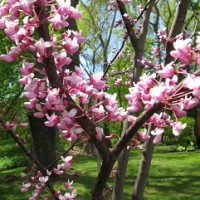
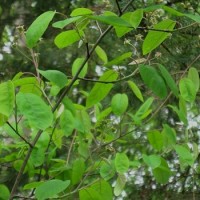
Among the evergreens that do well in shade, the Dwarf Alberta Spruce can handle significant shade, is slow growing, and is one of the few plants whose cold-hardy root systems can withstand being grown in a pot even through a Chicagoland winter. This Dwarf Albert Spruce (Picea glauca, below left) has been growing in a pot for 5 years. Their root systems are not large; their slow growth keeps them an ideal size for winter interest by the front door; and their new growth forms bright green “candles” that do not need trimming. Yews (Taxus, below right) come in upright and spreading forms. If you’re replacing some of these versatile foundation plantings, make sure of which type you have. I keep mine hand-trimmed to maintain a somewhat less formal look, but they respond well to mechanical trimmers.
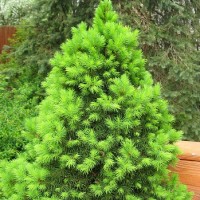
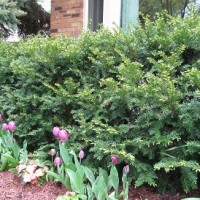
Here are some of my favorite flowers for shade. Deadnettle (Lamium, sp) comes in a variety of leaf forms and flower colors. This one (foreground below, left) is “Pink Pewter” and is followed by Vinca, Sweet Woodruff, Lily of the Valley and Ostrich fern. I have some blue lungwort whose flowers resemble bluebells, but this variety “Raspberry Splash” (pictured below) provides a nice color contrast to wood violets and pink columbine. Another fine feature is that deer don’t like any of these.
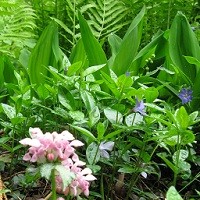
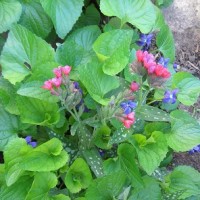
Likewise, bleedingheart (below, left) can handle shade and deer don’t like them. Astilbe, Aconitum (below, right) will be later to bloom and I spray my hostas with TreeGuard to keep the deer from devouring them.

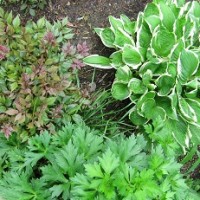
Why do some plants not tolerate shade?
It has to do with several plant characteristics. First, not all plants have the kind of capabilities in shady environments as shade-loving plants. Plants adapted to shady environments will often have (1) thinner leaves, (2) larger leaves, (3) more chlorophyll–the green pigment in leaves that helps with photosynthesis, and (4) these plants are more concerned with light harvesting than building leaf bulk. Sunny plants, on the other hand, build up protective mechanisms and structures within the leaves and will have a different ratio of pigments in order to protect themselves from the intensity of the sun.
Why is this important? For two reasons: (1) it means that some plants will never survive in sun or shade depending on its ability to adapt to the environment, and (2) it is important to allow seedlings grown indoors or plants grown in full sun to adapt—a process called acclimation or hardening-off (in the case of seedlings).
Have you ever taken tomato seedlings you’ve carefully pampered inside and brought them outdoors and they seemed to fry out in full sun? Tomatoes are supposed to have full sun, right? Yes. But they need time to adjust to the increased light conditions outdoors. So acclimating the seedlings gradually over a period of a week to 10 days will give them a chance to thicken their cuticles (waxy layer on leaves) and to structurally make changes to deal with wind, sun, rain, fluctuating temperatures, etc.
Of if you’ve ever bought a Ficus tree as a houseplant, brought it home, and it immediately dropped a lot of leaves, this is because it’s acclimating itself by putting off leaves that will be ineffective for your environment and putting on new leaves that will help the plant to survive in your home’s conditions.
Just as we were Created to BE Individuals, our understanding the individual characteristics of plants will help us to have a successful experience with garden and houseplants and demonstrate patience while our plants adjust to the changing seasons and their new environments.
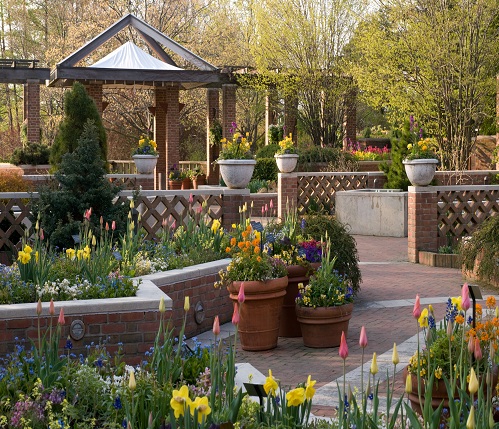
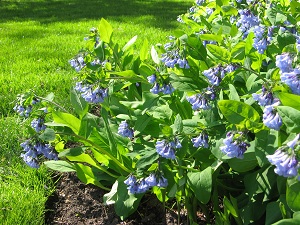
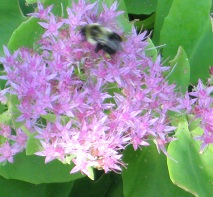 One of the miracles of plants is their ability to reproduce by means other than simply seed (which is miraculous in and of itself). While seeds form as a result of pollination of flowers (the plant’s natural sexual reproduction function—the birds and bees for the plant world), many of these same plants can also be grown from cuttings or divisions.
One of the miracles of plants is their ability to reproduce by means other than simply seed (which is miraculous in and of itself). While seeds form as a result of pollination of flowers (the plant’s natural sexual reproduction function—the birds and bees for the plant world), many of these same plants can also be grown from cuttings or divisions.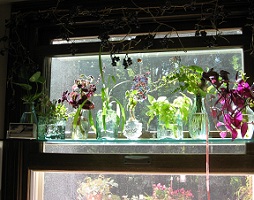 I have a couple of geranium varieties that will come indoors as well as some impatiens and coleus. Many cuttings will be started in vermiculite (as my post
I have a couple of geranium varieties that will come indoors as well as some impatiens and coleus. Many cuttings will be started in vermiculite (as my post 
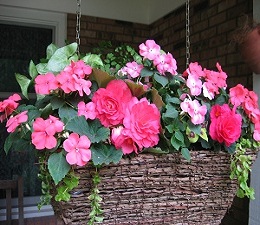
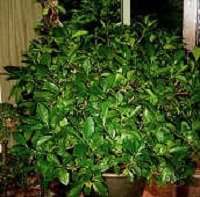 When the cold temperatures came, my plants were ready to come inside. I usually plan on doing the indoor-outdoor hokey-pokey dance for a week to ten days with my plants so that they can become acclimated to lower light conditions indoors. The plants come in. The plants go out. The plants come in and turn all about…
When the cold temperatures came, my plants were ready to come inside. I usually plan on doing the indoor-outdoor hokey-pokey dance for a week to ten days with my plants so that they can become acclimated to lower light conditions indoors. The plants come in. The plants go out. The plants come in and turn all about…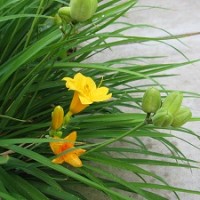 Of the frequently asked questions I received on the sales floor, people asked how to care for their daylilies. They’d bubble with excitement at seeing a big daylily that looked like this (right).
Of the frequently asked questions I received on the sales floor, people asked how to care for their daylilies. They’d bubble with excitement at seeing a big daylily that looked like this (right). 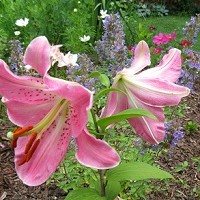 Plants have a legal name, if you will, that consists of a genus (larger group) and species (subgroup). Beyond that, certain cultivated varieties (cultivars for short) will have a name in quotes which makes it even more specific. The Oriental lily Lilium ‘Farolito’ shown here is a cultivar. Lilium x ‘Kiss Me Kate’ would be a hybrid lily denoted by an ‘x’ to show that it is a cross between a longiflorum lily (like an Easter lily) and an Asiatic lily.
Plants have a legal name, if you will, that consists of a genus (larger group) and species (subgroup). Beyond that, certain cultivated varieties (cultivars for short) will have a name in quotes which makes it even more specific. The Oriental lily Lilium ‘Farolito’ shown here is a cultivar. Lilium x ‘Kiss Me Kate’ would be a hybrid lily denoted by an ‘x’ to show that it is a cross between a longiflorum lily (like an Easter lily) and an Asiatic lily.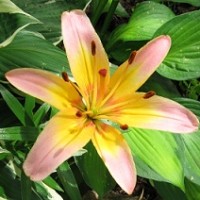
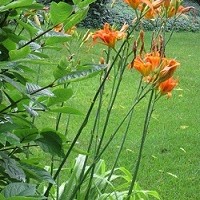 They grow differently in form—lilies (pictured on the left) are flowers emerging atop leafy stalks, daylilies (right) form clumps. They originate from different structures—lilies arise from bulbs, daylilies grow from fibrous root systems that will enlarge into spindle-like roots resembling tubers. Lily flowers are long lasting and open from the lower buds to the upper buds. When the buds have all opened, the flowering is completed for the year. Daylilies, on the other hand, have a short bloom—each lasting only a day, hence daylily, however the season of bloom may be quite extensive. Lily bulbs must be planted at a sufficient depth to protect them from the harsh winters, but not so deep that the plant must struggle through an endless stretch to reach the soil surface. Daylilies are planted so the crown is at the soil level with the fibrous roots and tuberous spindles are stretched out just below the soil surface. Lilies will grow larger clumps by growing increasing bulb sizes as well as by dropping bulbils (present after bloom in the leaf axils) off the stem onto the ground. Daylilies, depending on variety, can be downright invasive…emerging anywhere there’s an opportunity within the range of the mother plant.
They grow differently in form—lilies (pictured on the left) are flowers emerging atop leafy stalks, daylilies (right) form clumps. They originate from different structures—lilies arise from bulbs, daylilies grow from fibrous root systems that will enlarge into spindle-like roots resembling tubers. Lily flowers are long lasting and open from the lower buds to the upper buds. When the buds have all opened, the flowering is completed for the year. Daylilies, on the other hand, have a short bloom—each lasting only a day, hence daylily, however the season of bloom may be quite extensive. Lily bulbs must be planted at a sufficient depth to protect them from the harsh winters, but not so deep that the plant must struggle through an endless stretch to reach the soil surface. Daylilies are planted so the crown is at the soil level with the fibrous roots and tuberous spindles are stretched out just below the soil surface. Lilies will grow larger clumps by growing increasing bulb sizes as well as by dropping bulbils (present after bloom in the leaf axils) off the stem onto the ground. Daylilies, depending on variety, can be downright invasive…emerging anywhere there’s an opportunity within the range of the mother plant.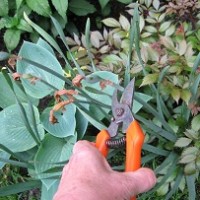
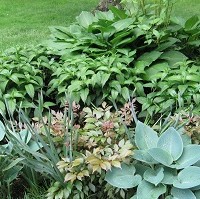 Pictured here are two instances of daffodil inter-planting. In the wet area of my yard, the hostas, astilbe, turtlehead have emerged and I can tuck the foliage behind these companion plants until it has completely died back. The foliage will continue to make food with plenty of sunlight and grow the bulk of the bulbs, then the summer perennials will fill the space left behind as the daffodils recede.
Pictured here are two instances of daffodil inter-planting. In the wet area of my yard, the hostas, astilbe, turtlehead have emerged and I can tuck the foliage behind these companion plants until it has completely died back. The foliage will continue to make food with plenty of sunlight and grow the bulk of the bulbs, then the summer perennials will fill the space left behind as the daffodils recede.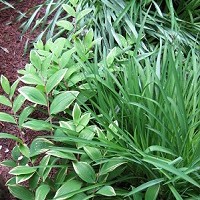
 Since a container garden must share the same watering requirement and light level, taking care to select compatible companions is helpful. Consider these hanging baskets I made from two window boxes back to back. They are hung from their back loops by using chain link (painted with craft paint to reduce its sheen). The back window box has maidenhair fern, ivy, fittonia, and nepthytis and the front window box has creeping jenny/moneywort, coleus, tuberous begonia, and impatiens. Since I will never rotate these, the front box will get brighter light and the back box will be even more shaded and moist. I like the stewardship present as well since the maidenhair fern, ivy, fittonia and nepthytis are all houseplants that I’m summering outdoors and the creeping jenny was recycled from early spring pots. I enjoy creating beautiful things primarily from what I already have on hand, plus an added item or two. Beauty from season to season!
Since a container garden must share the same watering requirement and light level, taking care to select compatible companions is helpful. Consider these hanging baskets I made from two window boxes back to back. They are hung from their back loops by using chain link (painted with craft paint to reduce its sheen). The back window box has maidenhair fern, ivy, fittonia, and nepthytis and the front window box has creeping jenny/moneywort, coleus, tuberous begonia, and impatiens. Since I will never rotate these, the front box will get brighter light and the back box will be even more shaded and moist. I like the stewardship present as well since the maidenhair fern, ivy, fittonia and nepthytis are all houseplants that I’m summering outdoors and the creeping jenny was recycled from early spring pots. I enjoy creating beautiful things primarily from what I already have on hand, plus an added item or two. Beauty from season to season!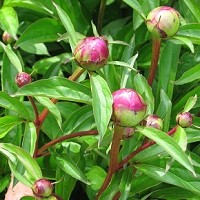 When I worked at Home Depot, I could guarantee this query at least a dozen times each weekend that the peonies were in bloom. Gardening has its share of pieces of Folk Wisdom and this isn’t one of them.
When I worked at Home Depot, I could guarantee this query at least a dozen times each weekend that the peonies were in bloom. Gardening has its share of pieces of Folk Wisdom and this isn’t one of them. 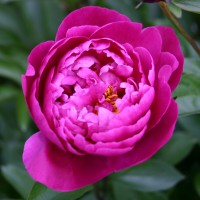 Peonies enjoy full to part sun, are heavy feeders, and come in singles and doubles as well a variety of colors. They can endure in the same location for decades and reward you with their beauty in the spring and their durable shrub-like foliage until the fall. They require some additional care with respect to planting depth and are best divided in the fall in order to bloom happily. They are some of the oldest cultivated plants for good reason—they are truly among the masterpieces of May.
Peonies enjoy full to part sun, are heavy feeders, and come in singles and doubles as well a variety of colors. They can endure in the same location for decades and reward you with their beauty in the spring and their durable shrub-like foliage until the fall. They require some additional care with respect to planting depth and are best divided in the fall in order to bloom happily. They are some of the oldest cultivated plants for good reason—they are truly among the masterpieces of May.







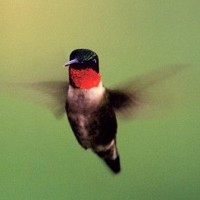 Part of the joy of gardening is the beauty of wildlife drawn to a well planned garden. I love birds. When I was a child, I kept a bird-watching journal and enjoyed identifying birds and their habitats. A long time ago, I abandoned the written journal, but mentally, I have a record of birds in the yard and when their seasons are.
Part of the joy of gardening is the beauty of wildlife drawn to a well planned garden. I love birds. When I was a child, I kept a bird-watching journal and enjoyed identifying birds and their habitats. A long time ago, I abandoned the written journal, but mentally, I have a record of birds in the yard and when their seasons are.